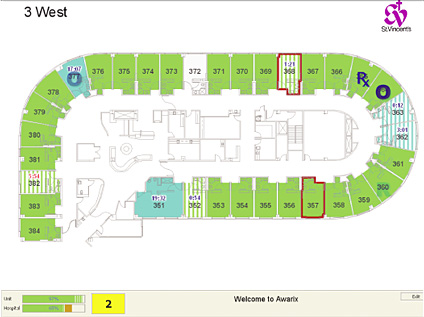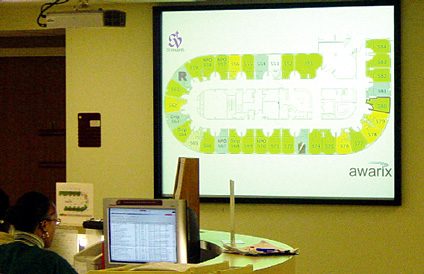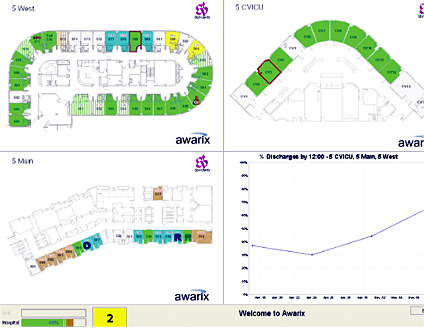Patient Care Visibility: Improved Patient Care At A Glance
January / February 2006
Patient Care Visibility
Improved Patient Care At A Glance
Today’s doctors and nurses are tethered to all manner of gadgets and devices — telephones, pagers, faxes, overhead pages, white boards, desktop computers, charts — in an attempt to facilitate the movement of information throughout the hospital enterprise. The result is that their environment can be noisy, demanding, and distracting — a fractured experience instead of an integrated one. While each of these current communication tools is helpful and works to meet a specific need, they are mostly point-to-point communication devices that can’t coordinate activity or effectively integrate information. For quality healthcare and for the patient’s safety, medical personnel need to know three essential things about each patient at all times during their hospital stay:
- Where is the patient?
- At what point in the process is the patient?
- What clinical events need to be done?
A decentralized work environment causes problems, not just for capable nursing staff, but for the entire enterprise. In fact, inefficient central communication is such a problem that gathering information — even as simple as the hospital census — can become extremely complex.
A patient care visibility system takes information from existing systems and makes it more readily accessible for the entire patient care team. Real-time broadcast communication systems are designed to help mobile users who need information in transit as they move through busy days, a system that is constantly updating information in a highly visible way and that doesn’t wait to convey information until someone checks in, a system that provides information to the enterprise at one time.
St. Vincent’s Hospital in Birmingham, Alabama, has successfully implemented a patient care visibility solution to help provide a seamless patient experience and to maximize resource utilization for increased income and improved quality of care. The key component of the system is the use of patient care communication boards that replace departmental white boards as the foundation for workflow information exchange in the hospital environment.
Patient care visibility is achieved by deploying large screen displays using LCD panels and projectors in every nursing unit, with views in bed control and physicians’ lounges, and with enterprise desktop access. Clinical staff can see stat orders and lab results while support staff can see how to prioritize service tasks. Administrators can instantly communicate current occupancy levels or emergency information to the staff. Information is taken from existing clinical systems and from location systems to create a synthesized single view, increasing awareness of patient care status in real time across the enterprise (see Figure 1).

![]()
Figure 1: Patient care visibility replaces the manual, departmental white board with large graphical displays that provide enterprise workflow information. Image courtesy of Awarix.
Patient care visibility systems synthesize all of this data in an at-a-glance format by using geospatial visualization. Colors and icons are placed on floor plans of each nursing unit to communicate much more efficiently than spreadsheet formats using columns and rows. For example, with a quick glance, a nurse can see that the patient in room 563 has a new order, a new result, is a fall risk, and is scheduled for discharge today at 1:30. Nurses can see all of this crucial information from a distance, as they walk through the unit — at-a-glance.
“One of the most frustrating experiences nurses have in their day to day work is that they need immediate information, but generally they don’t have access to it in a timely fashion,” notes Cindy Williams, CNO at St. Vincent’s. Currently, information that is put on paper or even reported with an electronic device is generally hidden and inaccessible from a mobile healthcare worker. For example, when a patient receives a critical test result, this information is only apparent to the patient care team when someone goes to actively seek this information at the nursing station. With patient care visibility systems, the information is made available in real time in a highly visible way, which increases staff responsiveness.
Consider this scenario: A patient needs medicine. Pharmacy has approved a medication order, and it is now available in the medication dispensing unit. The only way a nurse knows that this medicine is available is to log onto the machine and check for the order. A nurse may log in multiple times to see if the med is ready before it is actually approved. An Rx icon pops up over the patient’s room on the unit board signifying that the prescription is ready. With a quick glance, the nursing staff can receive and process this information while attending other tasks, thereby eliminating wasted time and steps.
Patient care visibility helps medical personnel prioritize their tasks. Tim Stettheimer, CIO at St. Vincent’s, speaks to some common problems facing nurses:
Nurses have to care for more patients at one time, and at the same time, they are deluged with more information than they have ever seen before. Our patient care visibility system doesn’t require nurses to sit down or dig through a lot of screens or point and click to find the information they need. Instead, as nurses are going through their daily activities and caring for patients, they’re able to see the situation at-a-glance, assess it, and know what kinds of things they need to bring to it. This is what nurses benefit from. They know, with confidence, what it is in their environment that they need to pay attention to.
Kay Buchwald, a nurse at St. Vincent’s, agrees: “Just to be able to look at a board and see and know how to prioritize your time gives a nurse a lot of power.”

Figure 2: With large screen displays mounted at key places throughout each unit, clinical staff can see stat-orders and lab results while support staff can see how to prioritize service tasks. Image courtesy of Awarix.
The visibility system also helps physicians be instantly aware of patient status. Before walking onto a unit, the physician can see if a patient is indeed present in a room or in another part of the hospital, for example, in radiology or physical therapy. He can see not only the location of the patient but also see how long the patient has been there. The physician saves time and can do rounds more efficiently. “The convenience of being able to access information that pertains to their patients is what physicians like about it the most,” reports Dr. William Leitner, CMO at St. Vincent’s. CEO Curtis James agrees:
Physicians respond positively to tools that make a difference in their daily activity. If it doesn’t improve their efficiency, they tend to ignore it. They will not use it. In fact, they will fight against its deployment. With patient care visibility, they’ve been wowed by something that’s visual in nature. They can identify issues that they face. It’s a tool that has helped them in rounding and attending.
Before, personnel spent time asking: Where’s the doctor? Where’s the patient? Where’s the chart? Now, staff can concentrate on specific care procedures and instructions with less frustration between doctors and nurses and case managers. Overall, patient care visibility improves the content of medical communications.
|
Enterprise patient care visibility also helps patient flow by providing an accurate picture of patient care status on the unit and in bed control. The system combats the serious problem of getting an accurate census of the hospital. Because of the powerful clinical impact of patient care visibility at the unit level, the accuracy of the system is maintained. Bed control has an at-a-glance view of the enterprise that is accurate. Hidden beds are no longer hidden, and good bed placement decisions can be made.
Patient care visibility brings real-time measurement to key performance indicators such as actual average length of stay, response from physician written orders to discharge, scheduled discharge compliance, observation patient status, and bed turn response. It provides the ability to look at real-time reports on all of these key performance indicators broken down by units, groups of units, or the entire enterprise, allowing hospitals to manage their units very efficiently. For example, a hospital may set a goal of 50% of discharges occurring before noon. The pitfall of the process is that there is no good mechanism for accomplishing this goal and no actual mechanism for measuring on a unit-by-unit basis whether or not the goal was achieved. Real-time feedback on key process goals is an important step in assessing and achieving goals to gain and maintain process change compliance.

Figure 3: Key performance indicator monitors show real-time throughout analytics such as scheduled discharge compliance, observation patient times, and hourly census by unit. Image courtesy of Awarix.
Enterprise patient care visibility integrates and centralizes essential information with at-a-glance accessibility for the entire patient care team. Hospital administration can oversee all departments and working parts of the hospital and make any necessary changes and adjustments so that the hospital will run smoothly and revenues remain strong. Doctors can use rounding time efficiently and communicate more effectively with staff. Nurses have increased responsiveness, can save steps and time, eliminate time-consuming information searches, prioritize their tasks, and spend more time attending to patients. Patients are more satisfied with their quality of care.
|
Gary York (gyork@awarix.com) is founder and chairman of Awarix, a healthcare technology company based in Birmingham, Alabama, that specializes in enterprise patient care visibility solutions. York has more than 20 years of experience in the areas of healthcare information technology and enterprise commercial software development. Previously he founded ComFrame Software Corp. and Emageon Inc. York holds a PhD in computer engineering from Carnegie Mellon University.
